
Original Link: https://www.anandtech.com/show/2214
Intel Developer Forum - Beijing 2007: New Centrino and a new Low Power Architecture
by Anand Lal Shimpi on April 17, 2007 9:00 PM EST- Posted in
- Trade Shows
Intel kicked off day two of its Spring IDF with some announcements about its next Centrino platform, codenamed Santa Rosa, and its successors.
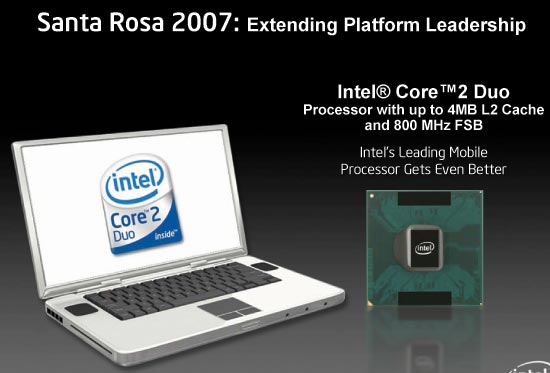
As we all know by now, Santa Rosa is the 2007 Centrino platform, which will officially start shipping in May. Santa Rosa is composed of Intel's Core 2 Duo processor, the mobile Intel 965 Express chipset, Intel's Wireless-N networking, Intel's Gigabit Ethernet as well as optional Intel Turbo memory. The latter is now the official marketing name for Intel Robson technology, which is on-motherboard NAND flash memory that can be used by Vista to speed up the OS via ReadyBoost or ReadyDrive.
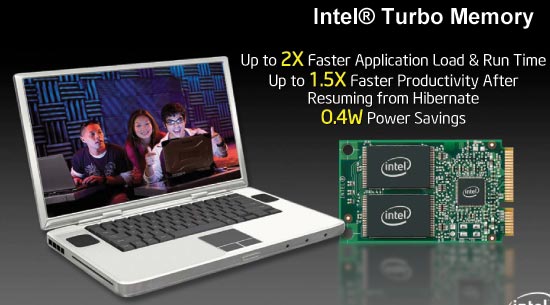
In the first half of 2008, Santa Rosa will get a refresh to support mobile Penryn processors. Currently Intel is only indicating updated processor support with the Santa Rosa refresh; the rest of the components may remain unchanged.
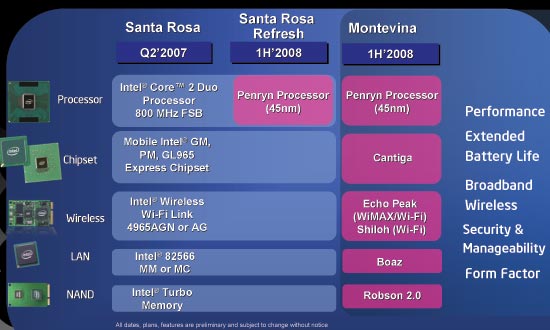
After the Santa Rosa refresh, also currently scheduled for 1H 2008, is the Montevina platform. Montevina will also support Penryn but it will be equipped with a mobile version of Intel's P35 chipset, codenamed Cantiga. Cantiga will bring about DDR3 memory support which may actually be attractive in notebooks due to lower power consumption. The real killer in Montevina is WiMAX support, which will hopefully enable very wide area wireless network access on notebooks in areas where there aren't localized 802.11 networks. Montevina will also bring updated Ethernet controllers and a second generation Robson technology.
The close proximity of the Santa Rosa refresh and Montevina launches does confuse us a bit, and we're skeptical of whether or not Intel will stick to this schedule. Two new Centrino platforms in a 6-month window just doesn't seem like a good idea.
Fixing UMPCs and a new type of UMPC
With Centrino Intel learned a very important lesson: to conquer a vertical market, you must do so with a very targeted architecture. The days of simply designing one microprocessor architecture and scaling it up and down to hit a variety of market segments are long gone. Intel conquered and expanded the mobile market by designing a new processor architecture that was power optimized, and simply maintained ISA compatibility with Intel's other processors. Eventually what made its way into Centrino and ended up going back into desktops and servers as well, but not until after a significant evolutionary process.
There's a new market that Intel first started talking about 1.5 years ago, back then it made its appearance on this slide as the "Handtop" market:
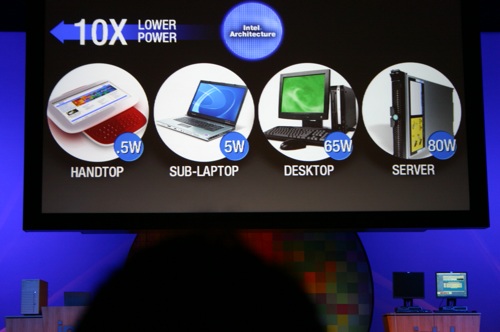
A year later, the Ultra Mobile PC (UMPC) was born, but unfortunately not into much success. In order for the UMPC to succeed it needs to have three things done right:
1) UI
2) Hardware
3) Ergonomics
The UI of the initial UMPCs was absolutely horrible, as they were all running Windows XP on very small, high resolution displays. Just as Intel discovered that you can't hide a boat with a car cover, Microsoft learned that you need a targeted UI as you address different markets (e.g. 10-ft UI for Media Center). The UMPC launch was not met with a Windows UMPC Edition and thus the UI requirement of making a successful device remained unfulfilled.
You also want these UMPCs to give you a similar experience to your desktop or notebook PC; they need to be fast and responsive. If a UMPC is going to have a full version of Windows running on it, then the hardware requirements (and cost) go up in order to keep the level of experience high. Unfortunately, UMPCs were basically built out of low power notebook parts, which as we mentioned from Intel's Centrino lesson, that's simply not the key to making a successful platform.
Finally the ergonomics on virtually all UMPC devices were just bad. The units were either too big or were in no way comfortable to use. Part of this requirement really depends on the hardware, and given that the first generation of UMPCs were built out of fairly stock notebook components they weren't optimally sized. With greater integration on the processor and chipset side, it's possible to reduce form factor much more.
Clearly the problem with UMPCs can't be solved by Intel alone; it will take an industry-wide effort to really make these devices successful but when it happens, the market will be huge. There is a very large gap between smartphones and notebooks; in the quest for being able to access all of your content, anywhere you go, you often need something that's a bit more powerful than a smartphone but not necessarily much bigger. You don't want to pull out your notebook simply because it is too big of a device for quick use, not to mention that there may be times when it doesn't follow you around. If the above requirements are met, UMPCs could evolve into something that could fill this gap (they may end up being the new smartphones down the line).
Intel also talked about a new type of ultra mobile device: the mobile Internet device (MID). Intel views MIDs as an alternative to UMPCs specifically to be used for primarily accessing the internet. MIDs will run Linux to help keep hardware costs down.
Centrino micro?
At this year's IDF in Beijing, Intel announced its 2007 Ultra Mobile platform, codenamed McCaslin, to be used for MIDs and UMPCs. Just like Intel develops platforms for notebooks (e.g. Santa Rosa), it is doing the same for the ultra mobile market. The 2007 Ultra Mobile platform is composed of three parts: an Intel A100 or A110 processor, a 945GU Express GMCH, and an ICH7U ICH. The latter two chips you already know, but the processor is something we'd never heard of before.
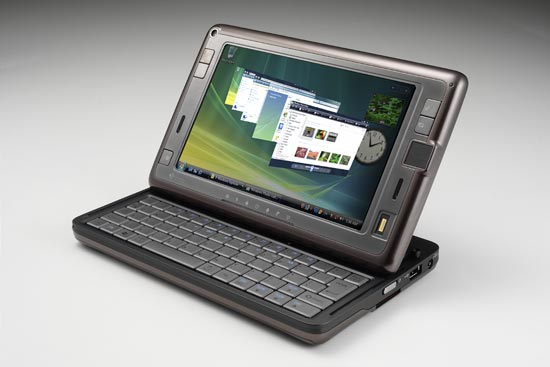
The HTC Shift based on Intel's 2007 Ultra Mobile platform
The A100 and A110 are Intel's first official ultra mobile processor offerings, and are basically rebadged and underclocked 90nm Pentium M cores. The A100 runs at 600MHz while the A110 runs at 800MHz, each with a 512KB L2 cache. At these low clock speeds, Intel lists the TDP of the two cores at 3W, fairly low compared to most notebook processors but still far away from the < 0.5W that Intel targeted back in 2005.
Never fear, as Intel went on to describe its 2008 Ultra Mobile platform, codenamed Menlow. In the first half of 2008 Intel will introduce a new low power micro-architecture with its Silverthorne processor. Silverthorne will be built on the same 45nm Hi-k process that Penryn will use at the end of this year. Intel didn't say anything more about Silverthorne other than that it would use a new chipset codenamed Poulsbo. According to Intel, both Silverthorne and Poulsbo were designed from the ground up to be used in UMPC and MID platforms. We believe that Silverthorne is Intel's 0.5W part, and according to Justin Rattner it will require 1/7 the total space of current mobile platforms to implement which should enable better sized UMPCs. Of course, Silverthorne will still be based on IA although it will most likely be 32-bit only given power and die size constraints.
Final Words
Today's announcements were predominantly mobile focused and the fruition of what Intel is talking about today won't be seen for years to come. We are glad to see that Intel is focusing on delivering an even lower powered, IA-based micro-architecture to target handheld devices. While the A100/A110 processors won't be the CPUs that will solve all UMPC problems, Silverthorne in 2008 is a step in the right direction and if Intel can really bring power down to sub 0.5W levels by the end of the decade we should be in good shape.
If Intel can deliver a power optimized, reasonably fast, reasonably small form factor processor and platform for handheld computing in the coming years we have no doubt that an Apple or Microsoft would easily take advantage of it and turn the UMPC into something useful and attractive.
IDF isn't over yet; there's just one more thing left. Check back later today for our final update....







